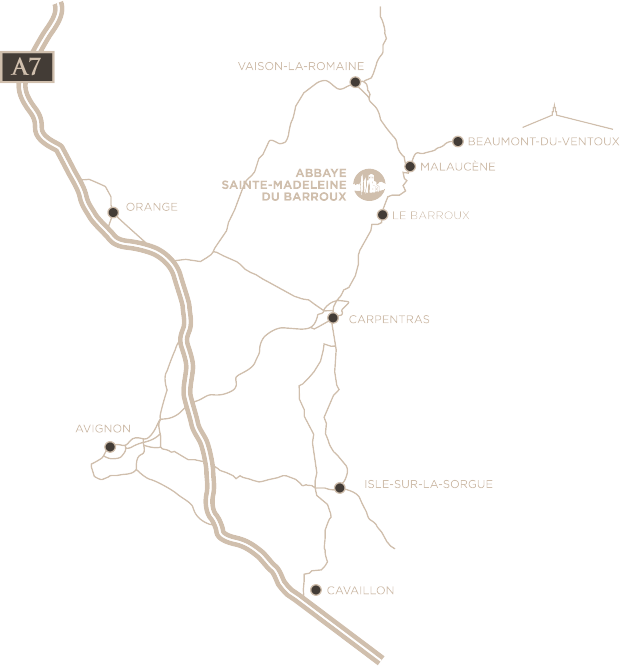A province is land that is given to man so that he can organize it into terroirs. So that, with a plow, tools and machines, taking things as they are and making them as they should be, he humanizes the landscape and, in doing so, develops his own quality of being a man. From these terroirs, that are all connected to each other, he builds a province in which ways of thinking become accepted, and in the same way, from these provinces connected to each other, he shall build a great country.
Henri POURRAT
THE CARITATIS TERROIR
—
An exceptional terroir
In the heart of the Papal Provence, perched at a height of 1,000 to 1,150 feet, between Mont Ventoux and the Dentelles de Montmirail chain, the Caritatis Winegrowers’ vineyard and the two abbeys of Barroux benefit from a magnificent terroir and climate. Part of the Ventoux AOP (Protected Designation of Origin), our vineyard extends from the eastern ridge of the Dentelles de Montmirail, which overlooks the little village of Suzette, to the northwest foothills of the Giant of Provence (Mont Ventoux). This means that the wines produced from this terroir share a fairly close geological link with some very prestigious neighbors, that include Beaumes de Venise, Vacqueyras and Gigondas. They also benefit from a wonderful mountain freshness…
The tremendous potential of the Côtes du Ventoux was recognized in ancient times by our Gallo-Roman ancestors, who were the first to plant vines in the area. Mentions of Ventoux’s wines can be found in historical documents dating back to the fourteenth century; they were popular with nobles and royalty, there is even an order from Pope John XXII.
The complexity of the landscapes of this region is related to its physical diversity, and the wide variety of crops; traditionally a fruit growing area, wine grapes grow alongside “Muscat du Ventoux” table grapes, olives, cherries and apricots; there is also great diversity in farming practices. In all the communes in which vines are abundant, such as Barroux, Malaucène, Beaumont du Ventoux, Entrechaux, Mollans and Crestet, there are a succession of fruit blossoms from April to June offering a wonderful palette of colors: first cherry blossom, then apricot, olive and, last of all, the vines. In this region, biodiversity is not an academic idea, it is a living reality.
Here is how the French Landscapes Agency described the region “Between Ventoux and Dentelles” in its Diagnostic of the landscapes of the Ventoux PDO in 2005.
« At the end of the Tertiary era, East-West Pyrenees-Provence folds and North-South folding of the pre-Alps created these rugged landscapes, driven by the Nimes fault, which was the largest in the Rhone Valley orogeny. This chaotic, fractured landscape is characterized by the vertical aspects of the Dentelles de Montmirail. The emergence of the Dentelles due to a compression phenomenon unique to the Rhone valley (known as the “Suzette diapir”), enabled geological formations separated by 200 million years to appear side by side, for example, the Triassic and Oligocene in Barroux.
Vines are grown in the valleys and on the hillsides, often on small plots. This mosaic of vines is mixed with other fruit crops or bordered by natural vegetation. There is complexity both on the landscape’s surface and in its undulating form, creating rhythmical, colorful compositions.
The vines thus present well-identified and very diverse terroirs, such as the scree and pebbly alluvium from Mont Ventoux’s steep limestone slopes or the restructured trias of the Dentelles, often colored by the presence of orange-red cellular dolomite, that is excellent for vines.
The massif is largely wooded, but substantial areas are also covered by crops, with terracing on steeper slopes, up to an altitude of about 2,100 feet. »
AN EXCEPTIONALLY
MILD CLIMATE
—
As everyone knows, the Mediterranean climate provides generous sunshine and the Mistral, our dear north wind, bathes the vines in a steady breeze, reducing the risk of mold and disease. Fortunately, the barrier created by the Dentelles de Montmirail and the foothills of Mont Ventoux protects the vineyard from the excesses of the Mistral which, while having many qualities, can also be a considerable threat.
When it blows at 75 mph on the Plan de Dieu, or at Chateauneuf-du-Pape, it is a more manageable 50 mph in our vineyard, and does not tear too many leaves off the vines or break any branches, and does not suddenly make the whole atmosphere too cold.
The moderate altitude of Mont Ventoux’s northwest slopes keeps a degree of freshness while decreasing the threat of diseases and pests, and the hillsides provide plenty of ventilation and sunshine. In a varied and yet balanced way, our vineyard combines the best features of this microclimate.
The Caritatis
TERROIR’S SOIL
—
Furthermore, the different soil types complement each other: Triassic rock, deep clay-limestone soil, and light, well-drained sandy-alluvial soil, enable us to bring out the best in the grape varieties. For the reds and roses, there is Grenache, old Carignan, Syrah and Cinsault; for white, there is Roussane and Clairette. The fairly arid, pebbly soil is perfectly capable of sustaining a grand cru vineyard, as has been demonstrated by the technical analysis carried out by our friend and adviser, Miguel.
The nature of the soil, its depth, its water supply and the pedoclimatic environment in which the vines will grow, will determine some of the wine’s characteristics and its complexity.
The soil where CARITAS’s vines are planted is located in the northern and central zones of the Ventoux appellation, in the Malaucène basin and the Carpentras amphitheater, broadly a product of tertiary sediment, hard limestone and ancient pebbly alluvium.
CARITAS is in an area where the dominant soil is brown limestone (34.8%), orthents (33%), not very evolved colluvial soil (11.6%), rendzina (12%) and, to a lesser extent, fersiallitic soil (8%) and trias (3 to 5%).
Brown limestone soil, which is very common in the area, develops under the influence of a great abundance of calcium carbonate which slows the process of the bedrock breaking-down and slows humification by the stabilizing humic compounds and protecting against biodegradation. This presence of limestone ensures good soil structure, but it is likely to render micronutrients, such as iron, manganese and boron insoluble. The winegrower has to monitor for possible deficiencies and study other more significant factors for vines, such as the slope and the thickness of the soil profile that will determine its capacity to retain water. The water supply to the vines needs to be rationed in order to produce a good quality harvest.
Colluvial soil also has valuable properties for wine production; but there are also constraints related to its texture, such as limestone, a significant quantity of pebbles or an obstruction deep in the soil.
CARITATIS vines also grow in fersiallitic soil that is similar to the brown limestone soil in terms of its effect on the wine. It appears to be particularly beneficial in combination with the brown limestone soil on the terraces of ancient Quaternary alluvium.
The agronomic suitability of soil is determined by general characteristics, measurable in all types of soil, and then by its special characteristics.
In terms of general characteristics, the plots lie on land with an average slope of 10 to 15%, but we have recently planted vines on “bancaous” (strips of land on terraces) where the slope exceeds 15%, and on orthents. The constraints are significant, but we are happy to reduce production in order to increase quality and strength of character.
The texture of the soil types varies between clay-sand alluvium and clay-alluvium sand, with an average clay content of 25%; but we also have plots with a lower clay content, with a clay-alluvium sand texture.
The useful water reserve, which corresponds to the amount of water that the soil can absorb and return to the plants, is 1.50 – 1.80 mm/cm of fine soil, which is very acceptable for the high quality that we are seeking.
In terms of special characteristics, the high proportion of active limestone is the main problem with the soil in the area, because it determines, with the free iron content, the capacity of the soil to cause chlorosis. This is a crucial factor when choosing the rootstock. We have to give preference to those that can adapt to soils that are high in active limestone (and so have a high chlorotic power index). Fercal rootstock is often suitable for these soil types. To keep the vines in good health, our winegrowers are sometimes obliged to correct iron deficiencies by spraying the leaves with a preparation rich in iron and trace elements.
Thanks | CGV | Legal notices | Website by © Orkidées, 2021 - Pictures: © Odile Pascal
Abbaye du Barroux & Vignerons Caritatis
-
1201 Chemin des Rabassières - 84330 - Le Barroux - France
Tél : +33 (0)7 77 08 25 09 ou +33 (0)6 95 90 39 85
Fax : +33 (0)4 84 50 84 57


